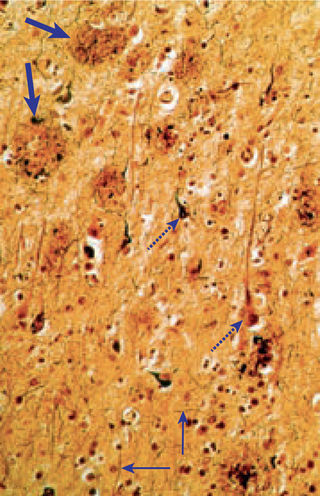Dementia
Alzheimer’s Disease: Pathology and Stages
Even once the plaques and tangles of Alzheimer’s start, it moves slowly. Part 1
Posted April 8, 2019
Today we begin a several-part series on Alzheimer’s disease, the most common cause of memory loss and dementia.
Alzheimer’s is a brain disease characterized by amyloid plaques and neurofibrillary tangles

In 1906 a psychiatrist named Alois Alzheimer looked at brain tissue from one of his patients under a microscope and first saw these amyloid plaques and neurofibrillary tangles. We now know that the plaques are a mixture of beta-amyloid, parts of brain cells, as well as other substances that are found between and outside the cells. Although there is much active research trying to understand the exact relationship between amyloid plaques and cognitive function, one possible link is as follows: When the plaques first form, they don’t necessarily cause problems, but once the ‘cleanup cells’ in the brain—part of the brain’s immune system—begin to react to the plaques, an inflammatory reaction occurs that disrupts communication between brain cells and interferes with brain function.
Damage to the cells from the plaques causes neurofibrillary tangles to form inside them. We call them “tangles” because they look like tangled string under the microscope. The tangles are composed of parts of the skeleton and nutrient system of the dying brain cell, also called a neuron. Ultimately, as Alzheimer’s disease progresses, more and more brain cells are damaged by plaques, from tangles, and die.
Alzheimer’s disease has many stages
Alzheimer’s disease starts in the brain years before any symptoms are noticeable. Over time, when thinking and memory begin to be affected yet day-to-day function is normal, the disease has reached the mild cognitive impairment stage, sometimes called, “mild cognitive impairment due to Alzheimer’s disease.” In this stage, learning new information is generally impaired. When function begins to be impaired we refer to it as “Alzheimer’s disease dementia.” In the very mild stage of dementia, the function is impaired just a bit; for example, individuals may no longer be able to perform the complicated activities that they did previously, such as remodeling a bathroom or hosting a large dinner party. Their memory problems may be worse such that they often misplace things, and finding words may be difficult. In the next, mild stage, forgetfulness and other problems with thinking begin to interfere with more routine activities such as cooking, shopping, and paying bills. Getting lost in familiar places and repeating questions and stories often become prominent, as new information is rapidly forgotten. In the moderate stage, daily living activities including dressing and bathing become difficult. Learning new information may be impossible, word-finding problems are prominent, and changes in behavior and personality may occur. In the severe stage, people with Alzheimer’s have difficulty communicating, recognizing family members, and the remaining continent. Even once dementia is present, Alzheimer’s disease is a slow process: without treatment, people with Alzheimer’s disease dementia typically progress from the very mild to the severe stage over a period ranging from four to twelve years.
Key Question:
Q: Your loved one has been told that they have mild cognitive impairment due to Alzheimer’s disease. Does that mean that they have dementia?
A: No. There are different stages of Alzheimer’s disease. The mild cognitive impairment stage means that there is difficulty with thinking and memory due to the plaques and tangles of Alzheimer’s disease, but the daily function is normal.
© Andrew E. Budson, MD, 2019, all rights reserved.
References
Budson AE, Solomon PR. Memory Loss, Alzheimer’s Disease, & Dementia: A Practical Guide for Clinicians, 2nd Edition, Philadelphia: Elsevier Inc., 2016.
Budson AE, O’Connor MK. Seven Steps to Managing Your Memory: What’s Normal, What’s Not, and What to Do About It, New York: Oxford University Press, 2017.


